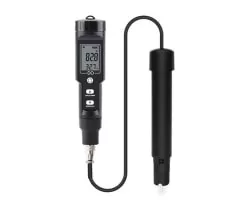The best way to select the ideal dissolved oxygen sensor. Dissolved oxygen is of utmost importance for bioprocessing and biotechnology.
The perfect management and control of dissolved oxygen bring about the change between high and low cell viability.
The best way to select the ideal dissolved oxygen sensor

The nature of dissolved oxygen sensors possible to buy
It is possible to purchase dissolved oxygen sensors of three basic varieties. They are optical sensors, galvanic cells and polarographic cells. Each of these plays a vital role in scientific research.
We have studied all those and detailed the pros and cons of each. This detailed analysis will help you to find the dissolved oxygen sensor ideal for your use.
Optical sensors
Optical sensors are the newest variety of sensors that you can use to measure dissolved oxygen. Though it is available since 2000, however, till recently it is not available easily.
The instrument works with the help of an external reader which incites fluorescence in a sensor spot located inside the cell culture.
The user has to correlate the concentration of dissolved oxygen based on the quenching effect the oxygen has on fluorescence.
If we have a look at the advantages they are as follows:
- A high degree of accuracy.
- Low maintenance gadget.
- Points of contamination are fewer.
- If stored dry, it can last up to 6 months.
The disadvantages are as below:
- As the technology is new, it is not approved for all natures of applications.
- Not possible to have continuous reading.
Polarographic Cells
The other names of this gadget are amperometric or Clark electrodes. It has an anode and cathode inside an electrolytic solution having a gas-permeable membrane. It is also possible to read 0% to 100% dissolved oxygen.
The pros of this gadget are as follows:
- It is in use since 1962 and the technology is widely known.
- It is necessary to calibrate it daily but it is easy to use.
- Possible to use in varied applications starting from cell culture to wastewater management.
The cons are:
- The gadget requires sometimes to warm up and so it can be time-consuming.
- There is the consumption of oxygen by this gadget so if you desire to have an accurate result it is not possible to use this.
- There is the requirement of constant calibration.
There are other disadvantages also.
Galvanic cell
It is a bit similar to polarographic cells. However, the primary difference is that this uses different electrode materials.
The advantages of this gadget are as follows:
- Due to the use of two different metals, you do not have to wait for polarization to happen.
- It is ideal for industrial and commercial use.
- The longevity of the gadget is for a year.
- The gadget is accurate and stable at a low dissolved oxygen level.
Some of the cons are:
- The media need to be in continuous movement as oxygen happens to be consumed.
- Requires daily calibration
If you desire to have the best quality dissolved oxygen sensor do contact us at Kacise Optronics Co., Ltd.
Related Guides









